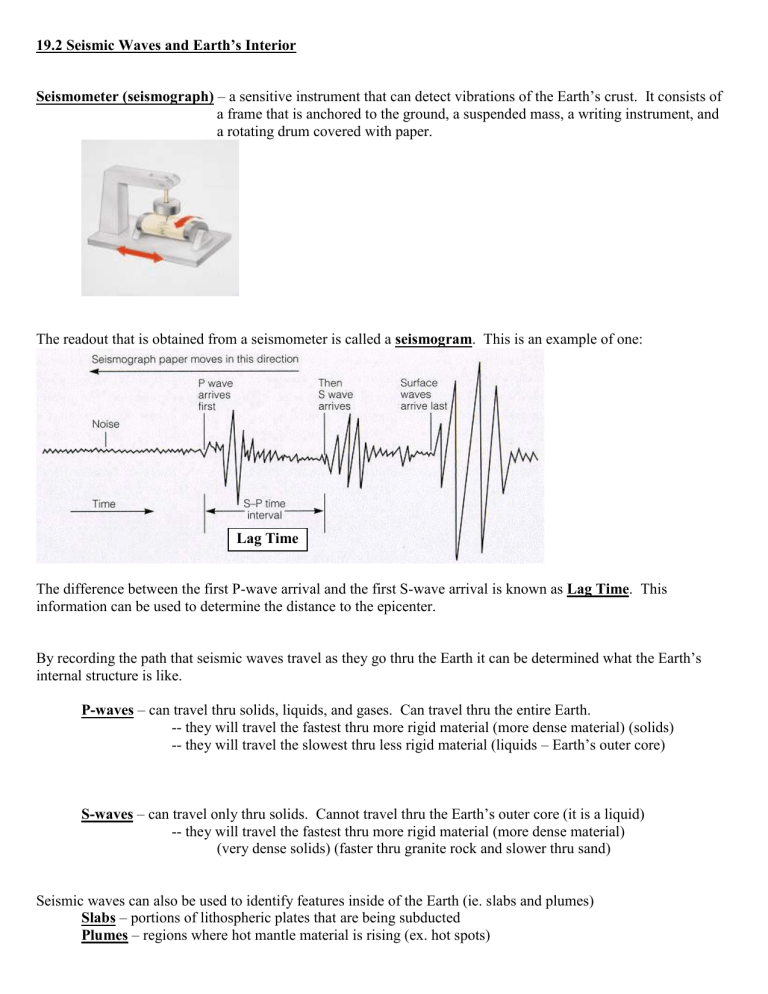Sect. 19.2 & 19.3 Notes Earthquakes

19.2 Seismic Waves and Earth’s Interior
Seismometer (seismograph) – a sensitive instrument that can detect vibrations of the Earth’s crust. It consists of a frame that is anchored to the ground, a suspended mass, a writing instrument, and a rotating drum covered with paper.
The readout that is obtained from a seismometer is called a seismogram . This is an example of one:
Lag Time
The difference between the first P-wave arrival and the first S-wave arrival is known as Lag Time . This information can be used to determine the distance to the epicenter.
By recording the path that seismic waves travel as they go thru the Earth it can be determined what the Earth’s internal structure is like.
P-waves – can travel thru solids, liquids, and gases. Can travel thru the entire Earth.
-- they will travel the fastest thru more rigid material (more dense material) (solids)
-- they will travel the slowest thru less rigid material (liquids – Earth’s outer core)
S-waves – can travel only thru solids. Cannot travel thru the Earth’s outer core (it is a liquid)
-- they will travel the fastest thru more rigid material (more dense material)
(very dense solids) (faster thru granite rock and slower thru sand)
Seismic waves can also be used to identify features inside of the Earth (ie. slabs and plumes)
Slabs – portions of lithospheric plates that are being subducted
Plumes – regions where hot mantle material is rising (ex. hot spots)
19.3 Measuring and Locating Earthquakes
Seismologist – a person who studies earthquakes.
There are several methods for describing the size of an earthquake.
Richter Scale – Developed in 1935 by a seismologist named Charles Richter. It is a older numerical rating system
That measures the energy ( magnitude ) of the largest seismic waves from an earthquake.
The height of these waves as they are recorded is known as their amplitude . An 8.0 earthquake is 32 times more powerful than a 7.0 earthquake.
Moment Magnitude Scale – A newer more accurate numerical scale that also measures the magnitude of an earthquake. In addition to measuring the energy released by an earthquake it takes into account the size of the fault rupture, the amount of movement along the fault, and the rock’s stiffness.
Modified Mercalli Scale – A scale that describes the amount of damage ( intensity ) that is caused by an earthquake. It rates the types of damage and other effects of an earthquake as noted by observers during and after its occurrence. It uses Roman numerals I – XII to designate the degree of intensity . The higher the numeral – the worse the damage. You are responsible for knowing the damage for I , VI , and XII. This information can be found on the chart in your textbook on page 540.
The depth of an earthquake focus
Earthquakes can be classified as being shallow , intermediate , or deep focus earthquakes.
Deep-focus earthquakes – This type of earthquake generally produces smaller vibrations at the epicenter than shallow-focus earthquakes. The reason for this is that the rocks at this depth are less rigid (more flexible). They do not have the ability to store a lot of energy. Also the seismic waves must travel a great distance to reach the surface so they will lose a lot of their energy.
Shallow-focus earthquakes – This type of earthquake generally produces larger vibrations at the epicenter than a deep-focus earthquake. The reason for this is that the rocks at this depth are more rigid (not flexible). They have the ability to store a lot of energy before breaking,
Also the seismic waves do not have to travel very far to reach the surface so they will retain a lot of their energy.
Seismic Belts
– The majority of the world’s earthquakes occur along narrow belts that separate large regions with little or no seismic activity. There are 3 major seismic belts:
Circum-Pacific Belt – Found around the Pacific Ocean. (80% of all earthquakes occur here)
Mediterranean-Asian Belt – Found running through the Mediterranean Sea region and southern Asia.
(15 % of all earthquakes occur here)
Mid-Atlantic Ridge – Found running down the middle of the Atlantic Ocean.









